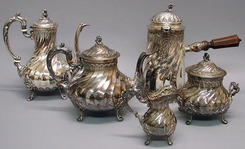 Crack open a container of cocoa mix today and what you have would be unrecognizable to centuries’ of hot chocolate lovers. And yes, centuries. Cocoa beans made the trip to Seville, Spain from Mexico in 1585, but that would have been unrecognizable to us, as it was not the cocoa powder we use (stripped of the rich cocoa butter) but something more akin to melting a chocolate bar and thinning it with cream. And then adding things like anise and chiles!
Crack open a container of cocoa mix today and what you have would be unrecognizable to centuries’ of hot chocolate lovers. And yes, centuries. Cocoa beans made the trip to Seville, Spain from Mexico in 1585, but that would have been unrecognizable to us, as it was not the cocoa powder we use (stripped of the rich cocoa butter) but something more akin to melting a chocolate bar and thinning it with cream. And then adding things like anise and chiles!
Naturally, it didn’t take long for something like an exotic, expensive drink to spread and the first chocolate factory was opened in London in 1657. On the Continent, chocolate drinking was pretty much exclusively reserved for aristocrats, but in England, where coffeehouses had opened only five years before, “chocolate houses” opened as well making the drink available to the middle class. (The English would also invent the process of solidifying chocolate.)
By the end of the 17th century, chiles were moving out of chocolate recipes and sugar was moving in in greater quantities, for, it’s posited, the very same reason chocolate became popular in the first place – scarcity equals exclusivity equals wealth equals status. Sugar, simply put, was a mark of prosperity and thus social standing.
It took roughly another hundred years, but by the end of the 1700s, chocolate had become something that would be at least a little more familiar to modern consumers. The processes of grinding the beans and integrating milk and sugar had been refined, but making chocolate was still an ordeal: the beans, which first had to be roasted and shelled, were crushed and then ground on a hot stone. Because of tastes and expenses, chocolate of the period was not nearly so sweet as modern chocolate and because of technological limitations it was not nearly so smooth either. People began molding chocolate in the 19th century.
Meanwhile however, drinking chocolate was the most common way to consume it and, as one would assume, with its associations with wealth and social standing, the drinking of chocolate (and coffee) required specialized pots, sets and cups. While the terms are now muddled, chocolate pots, coffeepots and teapots were distinctly different forms that were easily identified in the period. (All three are visible in the picture above with coffeepot, teapot, and chocolate pot from left to right with the cream pitcher and sugar bowl in front.) Teapots are easier – they are short and round-bellied to give tea the necessary room to brew and to keep water hot longer, because unlike their counterparts, tea was prepared in the teapot, not simply served in it. Coffeepots are more slender and taller with elongated, often arching, spouts. Chocolate pots are also taller than teapots, but their spout is typically shorter with the opening often just below the rim. Another difference between chocolate pots and coffeepots can be observed inside the pot: filters. A coffeepot has a screen-like filter over the base of the spout to catch grounds while a chocolate pot does not. Chocolate pots are also often distinguished by their odd handles. Unlike the loop handle on a coffeepot, chocolate pots frequently have turned handles sticking straight out of the side of the pots. Less commonly observed, early chocolate pots often had a hinged or removable finial, sometimes attached by chain, to allow for the insertion of a stirrer.
While eating chocolate has only grown in popularity, drinking chocolate never achieved the staying power of drinking coffee, due in large part to how much more complicated the production of processing cocoa beans is versus that of processing coffee beans. Drinking chocolate dropped out of fashion by the mid-18th century, to be replaced nearly one hundred years later by the use of cocoa powder to make something closer to the hot cocoa we know today.
In terms of market value, chocolate pots can fetch anywhere from a couple hundred to a couple thousand dollars, with the value resting heavily on their age and material (silver, of course, has a steadier price). The terminology is often muddled as well, with chocolate pots not necessarily being clearly identified as such or with coffeepots being called chocolate pots. Ultimately well-wrought ones in silver with marks for known silversmiths are the most desirable.



